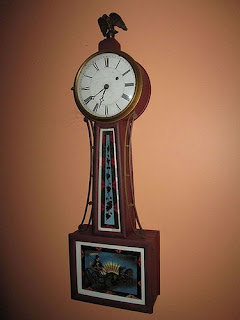 The beautiful Chelsea Clocks have been around for a long time and have a fascinating history. You can collect them as antiques or buy new Chelsea clocks and barometers. They make a beautiful addition to any home or office.
The beautiful Chelsea Clocks have been around for a long time and have a fascinating history. You can collect them as antiques or buy new Chelsea clocks and barometers. They make a beautiful addition to any home or office.How the Chelsea Clock Company Started
Throughout the history of time, mankind has been inventing timepieces. Some of the earliest clocks made in the United States were by two brothers, Aaron and Simon Willard in the late 1790s.
An excellent clockmaker, Simon Willard is best known for making the eight-day patent timepiece 1802, also known as the gallery or banjo clock, which became the first widely sold wall clock in the United States.
Edward Howard, who was an apprentice of Simon Willard’s nephew, Aaron Willard, Jr. started his own company in 1840. After having several partners and businesses, the company finally became the E. Howard Clock & Watch Company in 1857.
An apprentice of Edward Howard was Joseph Eastman who in 1886 started the Eastman Clock Company in Chelsea, Massachusetts. The company changed its name to the Boston Clock Company when in 1897; Charles Person bought the company and changed its name to the Chelsea Clock Company.
The First Chelsea Clocks
From the beginning, the Chelsea Clock Company always made the finest clocks and refused to deviate from that plan, even if the costs were high to make and to sell.
The first popular clock Chelsea made was in 1900, called the Ship’s Bell clock. These clocks are still being made and can be found in almost every port in the world today. They are not only popular in ships and ports, but also in homes and government offices.
Starting in 1903, Chelsea made what might be the very first clock in automobiles with customers like Rolls Royce and Studebaker. In 1906 they published their first catalog.
 |
| 1906 Chelsea Clock |
Chelsea Clocks Moves into the 20th Century
Prior to 1910, the most precise time regulators used for astronomy and scientific applications were made by Waltham Clock Company, Seth Thomas Clock Company, and E. Howard and Company.
Chelsea not only made clocks to tell time but the instruments to record weather including altimeters in airplanes. By the mid-1920s, almost every airplane had a Chelsea clock and altimeter in it.
In the 1920s, Chelsea Clocks made it both to the North Pole and the South Pole. In 1922 Chelsea clocks were used to find and measure the magnetic north pole and in 1928, Admiral Byrd used Chelsea clocks and instruments to record temperature, humidity and barometric pressure at the South Pole.
 |
| Banjo clock / Wikimedia Commons |
In 1930, Chelsea started to make and sell electric clocks to meet the consumers increasing demands for them.
When World War II started in 1941, the US government ordered thousands of Chelsea clocks and movements. Their clocks were found in every ship at sea including destroyers, submarines, battleships, and aircraft carriers.
The movements that Chelsea made and sold to the government were used for fire control and tracers. In 1943, they received the government’s E award for wartime production excellence (before 1961, these were called E pennants).
William Neagle retired in 1945 and longtime employees Walter Mutz and George King bought the company. After the war, the government continued to buy and use Chelsea clocks and instruments. They were used in bombers, nuclear missile silos, ships, and aircraft.
 |
| 1938 Chelsea electric clock and WWII 24 hour clock |
Chelsea Changes Owners Again
Walter Munz and George King sold Chelsea to Automation industries in 1970, who then sold it to the Bunker Ramo Corporation in 1972. In 1978 it was sold to Richard Leavitt.
In 2005 Mr. Leavitt sold Chelsea to entrepreneur JK Nicholas who still owns the company today.
Chelsea Clocks Today
Ever since President Woodrow Wilson, US presidents have had Chelsea clocks in the White House and given Chelsea clocks to visiting dignitaries.
The company still makes beautifully crafted clocks and jewelry at the same location where it started in Chelsea, Massachusetts.
Today you can buy antique, vintage or new Chelsea clocks along with accurate and beautiful barometers.
 |
| Chelsea clock and barometer |
Collecting Chelsea Clocks
These clocks have long been a favorite of antiques and clock collectors. The Chelsea Clock Museum also sells clocks to collectors.
You can see what they have for sale on their Vintage Chelsea Clocks for sale website.
Serial numbers are important to validate the years which certain clocks were made; you can check the serial numbers for Chelsea Clocks on their web site.
Copyright © 2010-2019 Sam Montana

No comments:
Post a Comment